The pinking hour

Town and lake, today's pink light photos on Flickr - go to the link (Flickr badge) near the top of this page.
The view from the back.
www.zidao.com Apprentice harmonizer, for sheer fun. Journeywoman writer, for work and pleasure. Starting point was Iowa, current stopping point on this journey is Switzerland, with frequent pauses around the world to watch and listen to the crowd, and occasionally make comments.
www.flickr.com
|

Town and lake, today's pink light photos on Flickr - go to the link (Flickr badge) near the top of this page.
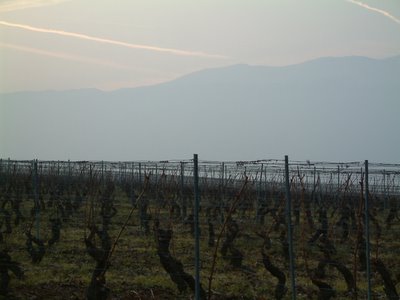 Peissy, 10 km from Geneva's city center, with the Jura mountains and the start of Burgundy to the west: January 30, dusk
Peissy, 10 km from Geneva's city center, with the Jura mountains and the start of Burgundy to the west: January 30, dusk
Skies darken over Peissy, daytime patches of melted snow freeze, sky travellers carry on to Paris and Milan
January is a quiet time in the vineyards. The plants pause, the lanes among the vines are empty and the only sign of human activity is streaks from jets overhead. The cries and shouts of hidden children's voices carry over high courtyard walls in Peissy and Choully.

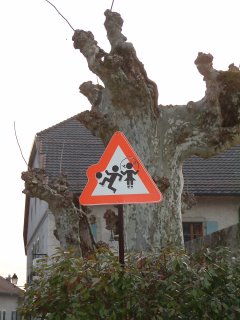
On an empty road leading away from Choully I came across this massive tree trunk, with this comforting sign on it. I liked the fact that someone in Geneva Canton cared enough about the old oak tree and its fellows to explain that these have long been the canton's most prolific species, that they have been used for centuries to age the local wine. The sign invited us to count the number of rings and guess at the age of the tree. It was too cold, so we passed on, in the direction of a vineyard called (in French) paradise.
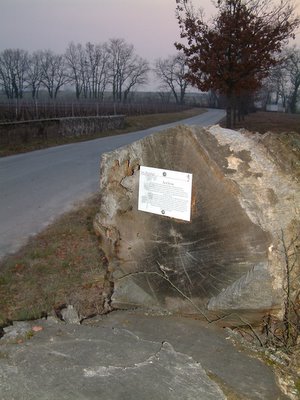
I counted those rings as I fell asleep, but I never made it to the last one.
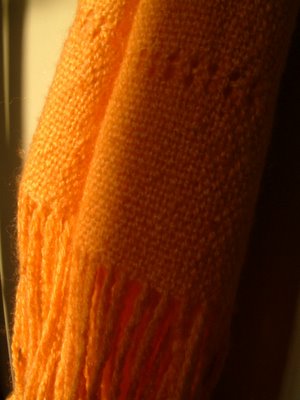
Santiago de Chile in orange: lights and shadows
Chile's new president is a woman, but more importantly, she is the fourth elected president in 16 years of democracy, since Pinochet's dictatorship was overthrown. The gunmen ran the place for 17 years, so the voters have nearly caught up.
I spent a little time in Chile, on a business trip to visit several schools three years ago. I bought this scarf at an outdoor market, a place I had walked to alone at night because teachers I'd met told me I could, that Santiago de Chile was a relatively safe city. A young woman with a face that had no European ancestors, and who spoke no English, managed to explain that these came from her hill town. The scarves were simple and not particularly stylish, but the colors were vibrant and the alpaca wool wondrously soft to the touch.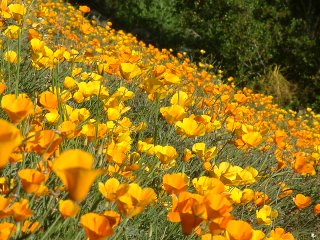
While winter was easing its way around the windows back home in Switzerland, spring was bringing magnificent flowers to fields and gardens in Santiago. The vineyards were turning green, in contrast to the brown Andean slopes that rose behind the city.

The best flowers were in the shantytown school that I visited, real ones in a garden lovingly tended by the parents and children of the school. The city did not have enough money to educate all the migrants streaming in and leaning one tin shack next to another, but the families hungered for education. A local international school, Redlands, joined forces with the families who had moved from the hill towns, and never have I seen such pride in a school community.
We talked about politics, about Pinochet and Allende, with some caution. Mothers talked more openly about their lives as maids in the rich homes across the gully from the school. Teachers talked about the problem of men and drink, and too little work. The city, but more particularly the shantytown, was streaked with the brightness of lives aching to be lived, and the shadows of poverty that left so much darkness, and yet it was a rich darkness.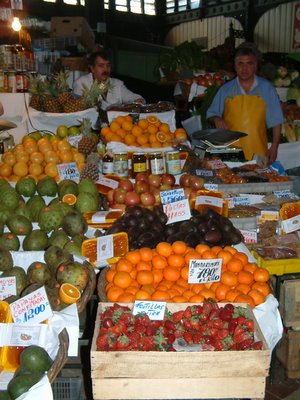
I look at my scarf on a January day in Switzerland, and its warmth and softness seem to carry threads of the light and shadows of Chile. I wish the new president a Chilean future worthy of the colors her country produces.
When I decided to turn my hand to blogs, my friend and work partner Mary Tiegreen decided to keep me company. From New York, at The Blue Bird Cafe, I would get her news, and from Switzerland, mine would fly to her. No one else visited these first attempts, and Mary soon found that work deadlines had a stronger pull than the blog.
She will get back to it, once her current 1001 Reasons to Love ... book reaches the publisher. I'm in the process of setting up other blogs - a newspaper, but also separating this one into various strands. Stay tuned!
Meanwhile, here's looking at you, little blue bird, may you continue to send us inspiration!
The sun burst forth this morning, after a gray start to the day. The mantel was brushed with soft light, and my eye was caught by a vase bought in Costa Rica six years ago.
I attended an education conference for a week. I then escaped the bureaucrats and drove along wild roads through the rain forest, onto the plains with dusty cattle ranches and beyond it all to the beaches where giant turtles come to lay their eggs. We missed seeing the midnight turtle parade, sadly, but after days of watching waves run wildly up empty, off-season beaches I saw this peaceful vase with its deep, rich colors overlaid with simple etchings that call to mind the country's lushness.
Sometimes I like to just drop out of the present and linger in the past for a few minutes, usually while the tea is brewing. This morning I was hunting online for information about a mysterious uncle in Iowa, so I went to a site called Iowa Old Newspapers. It coughed up such intriguing little lead lines about shocking local events of 100 or more years ago that I finally had to read one. Poor Uncle Ambrose was left in the dust by this tale.
Read all about it! This is the murder in cold blood of Mr. Blood (sorry for the bad joke, but it's true) by Mrs. Blood, in 1898. It gave me pause: the sympathy given to a woman who murdered her husband would not seem politically correct today and I've been debating with myself if this is progress. Mrs. Blood, I think it is.
On the other hand, it sounds like the sympathy was well placed, which would cause most newspaper editors today some problems with the sacred cow of objectivity in journalism, a relatively recent development. Add to this a new media fear of litigation and I think we might have lost something. I can't imagine any newspaper in the U.S. these days publishing this damning remark:
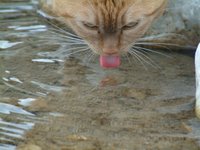
My apologies to a couple of people who left comments which didn't get posted - it looks like there was a problem around Christmas and New Year's Day and I didn't see these.
On some blogs you can see the comments right away, which makes the blog more like a forum, with discussions. I like that, but it can also make pages long. I'm looking at different layouts now and will change the look of my blog in the near future to make comments more apparent.
Meanwhile, there are two new comments that I'm very happy to have, in the last day - check them out! Cheerful little man has one, and so does Time capsule. Feel free to send yours. That's half the fun of blogs.

Wintry walk photos taken late in the day look a little gloomy and skiers coming in from the wild foehn winds are all tired. We light the fire and I take a picture of a cheerful little man. He is a present from my niece Heidi who visited two years ago and wondered what gift she could give people in a chalet. She was right: we didn't have a mountain man holding toothpicks and he's turned out to be very popular.

Across the Rhone Valley, then along the Val d'Anniviers
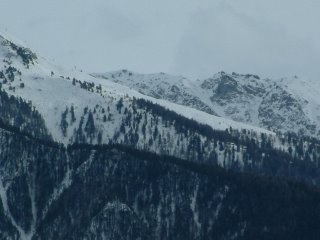
Up the slopes to the resort of St-Luc, which opened a new snow park with jumps.
I decided to walk in the woods, taking my camera and seeing what the world was like in place nearly hidden from the wind. Click on the Flickr badge above to see the pictures.
I've been reflecting, for a writing class, on the difference between a diary and an unpublished/unedited autobiography. Both are records of our lives and I suspect that if asked to answer without first reflecting, most people would say the first is a record of thoughts and the second a record of events. Each, when written well, contains elements of both. We might simply define them as written records of our lives.
Are blogs diaries, as they are so often labelled? Some are more like forums on particular topics but are the others used primarily to record our thoughts, our mental drift?
What about the role of photos then? Photos provide a good record of our lives and they can be used to richly illustrate our thoughts, as well as events.
I thinkwe've moved into the era of digital autobiographies, where image + text are now the components of diaries, and for the first time we can really interweave them. Some people prefer more text, others more photos. I like them best blended. As a writer, I tend to think of autobiography first in terms of words, with photos to back them up.
I've decided to start "writing" a digital images autobiography, as a means of seeing my life through another angle of the prism. On Flickr, I've just set up a set of photos called "Time capsules" where I've put five photos to start, and I will keep adding to them. The photos are objects from my life, all of which have some significance, and which trigger memories. Further down the line I will add text, I'm sure. For now, looking back comes first.
The first thing I've learned from doing this is how rarely I photograph durable rather than ephemeral objects - there are very few in my files, I'm surprised to discover.
I would love to see others starting digital time capsules, and sharing them.
An Iowa Garden
Beautiful photos and reflections on the secret lives of gardens, even in winter, from someone who keeps one near Iowa City. This is a place of gentle hills as the valleys of the Mississippi River and its tributaries gradually give way to the plains with their corn and wheat fields. Iowa City is where my mother earned her college degree (unusual for women in 1933) and met my father.
In one little image we have a world-circling time capsule with:

Best of all, the image is zooming around the world, through Flickr and Blogger, landing in any country where people who work online rein it in whenever they feel like it.
In honor of the 95 years since my mother was born, I decided to spend a little time looking on the Internet for images and information that would recall the place where she was born and lived most of her life, a town called Reinbeck in eastern Iowa. First, I pulled out the purple and yellow beads made of foil-filled glass that she was given as a high school graduation present in 1929, and wondered yet again where a girl in a small town in Iowa thought she might be wearing such magnificent new jewelry.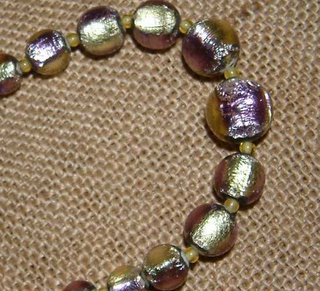 I found a wonderful Iowa public television web site, relatively new, with images and tales of Iowa. It included a photo from 1925 of the general store in Buffalo Center, where my mother would have her first teaching job about 8 years later. Did the store look the same and was it run by the same brother and sister, who are in the photo? Or did the Great Depression of 1929 close it, as it did so many other businesses? I found a 1939 photo from Reinbeck - a young man pouring a bin of hybrid corn, which was considered an earth-shaking invention in the 1930s.
I found a wonderful Iowa public television web site, relatively new, with images and tales of Iowa. It included a photo from 1925 of the general store in Buffalo Center, where my mother would have her first teaching job about 8 years later. Did the store look the same and was it run by the same brother and sister, who are in the photo? Or did the Great Depression of 1929 close it, as it did so many other businesses? I found a 1939 photo from Reinbeck - a young man pouring a bin of hybrid corn, which was considered an earth-shaking invention in the 1930s.
I found a lovely photo on the South East Iowa Antique Auto Club site, of a Ford car in 1917 in Iowa, about the time my mother would first remember cars, and imperfect roads.
My childhood was filled with small tales, dozens and dozens of them, about life and characters in the little town of 2,000 in the center of the U.S., because my mother liked to quote her father, saying that in a town that size you have one of just about every kind of person there is, doing all the things people will do.
For Florence Lonergan Wallace in Kansas City, whose 94th birthday is Thursday.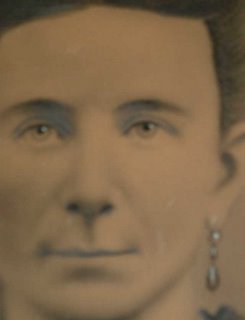
Her grandmother, Mary Ann Murphy McAvoy, and one thread of daughters: She had a daughter named Anna, who had a daughter she called Florence, and she had a daughter named Ellen, and my daughter is named Tara, after the hill of peace in Ireland.
The wind blows across Switzerland
We left the mountains this morning, very early, and drove down to the Rhone Valley. The Alps were still and starry. The car bumped and rocked, but only the driver noticed that it was the wind that did this.
In Saint-Prex the wind woke us up rudely, pushing at the car doors when we wanted to open them and tugging when we tried to close them. Collars were pulled tight and eyes squeezed shut and we had to shout over the roar of the wind whipping across Lake Geneva and shaking the tall trees around the old Manoir that stands at the tip of our village, a beacon to sailors in summer.
Science on wind
When Liam was four he asked where the wind came from and when he was six he asked why it gusts and dies down. We read answers out of a book. I tried to remember all day what those answers were and I found them again this evening in an odd place, a news channel's web site post in Seattle, from 2003.
History on wind
The where and the why of windiness never change, but that's only half their story. The rest is in our Wind drawer, near the Moonbeam drawer. There's a bit of white sand down there from the Gobi desert, cold sand now that it's winter, but the sand was warm the day a few grains trickled in there, the day the wind was wound up.
The tale from the Wind drawer
A very long time ago, when people began to invent things to make their lives easier, there was a lonely, miserly man who lived in Mongolia, at the edge of the Gobi desert. Few people lived there because there was little food and less water. When he was a young man he found a small place with a water hole that never dried up. He watched and held out his hand to feel the air as the wind moved across the water, rippling it. He thought and thought and one day he invented a way to capture the wind, to harness her to what he called a windmill.
The wind wanted to be free. She didn't like being invisible and not being her own master. Worse, she knew she could be stronger, and she wanted to test that. One day she blew so hard that she blew down the windmill! First happy ending: The miller cried, but fortunately a good woman happened to be walking across the Gobi desert and she decided to keep him company, so the two of them grew old together and the miller, who had learned his lesson, never tried to harness her.
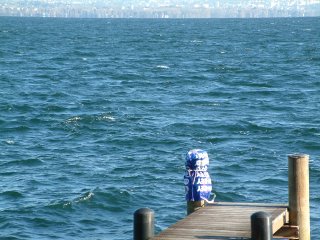 Second happy ending: Meanwhile, the wind learned that when she skipped over the land she picked up speed and more power. Better yet, she learned that the sun could give her speed, too, and water added to the fun.
Second happy ending: Meanwhile, the wind learned that when she skipped over the land she picked up speed and more power. Better yet, she learned that the sun could give her speed, too, and water added to the fun.
She sang as she headed across the forests of Siberia, skipping over Lake Irkutsk. One day she came to the wide plains of Russia, and the grains of Gobi sand she carried with her warmed in the summer sun. She felt sleepy and learned that the flat stretches slowed her down. Some days she just drifted along.
By the time she came to a place that was later called Berlin she had learned to move and leap and fly and run and twirl. She could sing and whistle and Berlin was the better for it. The wind by now knew she could never be completely tamed again.
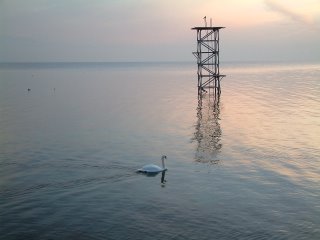 And yet, journeying across the Earth, she began to tire of the endless motion and seamless voyage. One day she discovered the secret of making small breezes, and for some time that gave her great pleasure.
And yet, journeying across the Earth, she began to tire of the endless motion and seamless voyage. One day she discovered the secret of making small breezes, and for some time that gave her great pleasure.
 Soon she had four of them: her daughters. They picked up the thread of the wind and carried it further. By the time they had drawn loops around the globe they learned new secrets. In Russia they saw how to carry snow so they were no longer invisible, and in Lapland how to tease autumn trees into brighter colors so they could dress up and party all night. In Ireland they whirled around the hill called Tara, where the four kings who fought all year came together one day every year to make peace. It was in Ireland that the winds discovered the secret of burning peat so the ancient boglands could begin to turn up their hidden treasures, such as the Tara brooch.
Soon she had four of them: her daughters. They picked up the thread of the wind and carried it further. By the time they had drawn loops around the globe they learned new secrets. In Russia they saw how to carry snow so they were no longer invisible, and in Lapland how to tease autumn trees into brighter colors so they could dress up and party all night. In Ireland they whirled around the hill called Tara, where the four kings who fought all year came together one day every year to make peace. It was in Ireland that the winds discovered the secret of burning peat so the ancient boglands could begin to turn up their hidden treasures, such as the Tara brooch.
They eventually tired of their wild ways and settled down, but they and the Earth and Sun, as well as lakes and mountains and rivers, had learned to love each other, to tug and tease and pull at each other. They knew that to wind up the wind they had to live in harmony
To this day, the four winds that come from north, south, east and west twirl around the world and some days they blow strong and hard, and some days barely at all. They do it to show us that bumping along quietly together one minute can create great, glorious gusts of life another. And that is a beautiful thing when it happens.
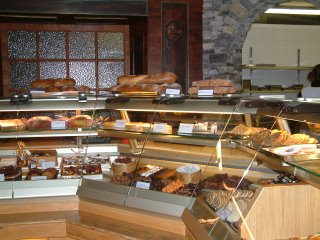
Switzerland has a great variety of bread, and it is delicious. We eat a mere 49kg of bread per person in a year, compared to 150 in neighboring France and Italy. Bakeries (one for every 2,500 people) are part of daily life and pre-sliced supermarket bread with preservatives is usually reserved for emergencies. I think the Swiss, who eat a lot of potatoes, prefer quality to quantity where bread is concerned. Maki, who lives in Zurich and writes about food from the perspective of a Japanese person raised partly in the US and the UK, now living in Switzerland, believes the Swiss have a healthy diet and sensibly end sociable meals with a bit of exercise.
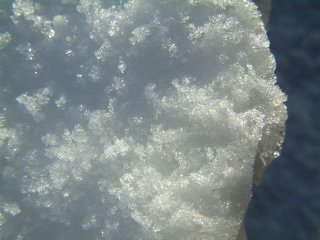 Sunday was a beautiful Alpine day, with more blue skies, good snow and icicles dripping only if you stood under them. Corrugated roof icicles are special because they grow more horizontally than vertically.
Sunday was a beautiful Alpine day, with more blue skies, good snow and icicles dripping only if you stood under them. Corrugated roof icicles are special because they grow more horizontally than vertically.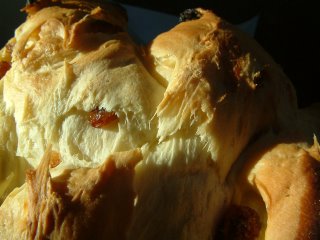 Sunday afternoon at our house, people coming in from hiking, skiing and snowboarding had taillaud from one of my favorite bakeries, across from the ice skating rink in Crans-Montana. This is a Neuchatel specialty, but it's just as easy to eat in the Valaisan mountains.
Sunday afternoon at our house, people coming in from hiking, skiing and snowboarding had taillaud from one of my favorite bakeries, across from the ice skating rink in Crans-Montana. This is a Neuchatel specialty, but it's just as easy to eat in the Valaisan mountains.
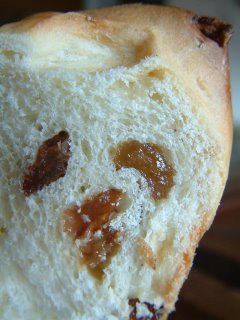
 For four weeks only small birds visited the snowy patch out back. Today we found signs of a visitor(s). But what variety? Vaguely paw-like marks but a creature of virtually no weight, and all prints seem to face forward, towards the mountain view. And yet so many tracks! We don't have rabbits here, or at least no previous evidence of them, such as nibbled lettuce. Tomorrow I will hunt for a good print among the dozens out there.
For four weeks only small birds visited the snowy patch out back. Today we found signs of a visitor(s). But what variety? Vaguely paw-like marks but a creature of virtually no weight, and all prints seem to face forward, towards the mountain view. And yet so many tracks! We don't have rabbits here, or at least no previous evidence of them, such as nibbled lettuce. Tomorrow I will hunt for a good print among the dozens out there.

In the Alps, near the resort of Crans-Montana, we tend to have blue sky above our snow line.
Early, before the sun rises, clouds run across the sky. Here they are moving north, from Italy to Germany.
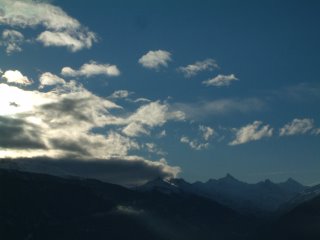
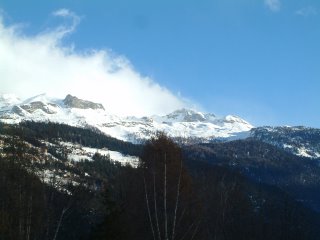
10am and the clouds are running away, to the north, freeing the skiers' slopes

2pm and above the snow line, only blue sky in the Swiss Alps
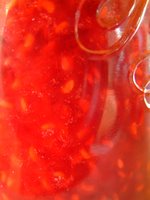
How we hold onto summer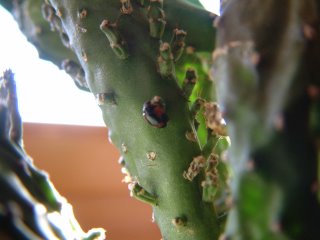 The ladybug and the cactus
The ladybug and the cactus
All creatures need to capture a bit of summer and hold onto it during cold winter days. This morning I remembered to water a long-dry and unattractive cactus plant. On it I found a little ladybug, or some cousin of hers, perched on a hidden cactus tip. She looked a bit drunk, so perhaps it is true that a cactus holds water, even in my house, long after it has last been given to drink.

 The family and the raspberry jam
The family and the raspberry jam
We capture summer by picking raspberries like mad in July, turning them into what I think is the world's best jam, then eating it all winter long. I like it best when the winter sun suddenly rises above the mountains and streams onto my table, lighting the berries the way it did early on July mornings.
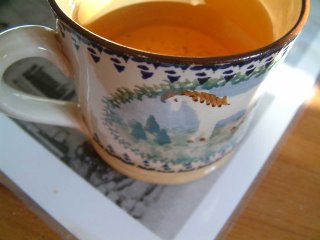 Tea en route to work
Tea en route to work
Going to work in an office at home also has a pattern but there is more variety here. I used to fret that I procrastinated, during the 15 years I did freelance journalism. Then I took 5 years off and joined the office workers. Getting back to work with my company's offices in my home, I suddenly realized my day starts just like any outside office worker's. The details of the routine are just a bit different.
It goes like this, and there is no sense, I've learned, in taking shortcuts:
The minutae today include: sunlight streaming through the street lamp outside, a plant in bloom, the horse on my 20 year old teacup made by Nick Mosse in Ireland, the inexpensive earphones that allow me to talk to family and friends around the world for peanuts on Skype, the only teapot whose lid has lasted more than five years with a rhino tea cozy from South Africa. Take a closer look - that's how I start my day, and it works.
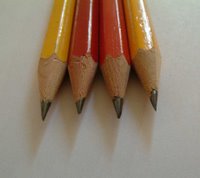
Doing their best to prod me to work
There was a bit of procrastination, photographing pencils.

The Pencil Sharpener and I
I love my pencil sharpener, the one that works. Three of them don't, or only halfheartedly. They leave dull tracks and the pencils that have suffered them sit on paper the way the circus fat lady settles into an easy chair. Lead spillage.
My pencil sharpener is bright and cheerful. It holds beautiful shavings of wood that I can see and smell. It rarely breaks lead tips. It was very cheap. It connects me to China, a place I love. And it brings my pencils straight to the point. To the point
To the point
Computers are wonderful, but pencils are treasures. As they poise (never hover) over paper, for just a moment all our thoughts run down to that tip and are beautifully focused. What we are about to write will flow with a rich neatness and precision.
Pencils capture all our potential. We see it when we sharpen them and set them down in an uncluttered place. Stare at a pencil and everything you have ever wanted to write well stares back at you.
My father used to park his sharpened pencils in neat rows, ready for the hard work of an engineer who loved to arrange and rearrange numbers, as I thought at the time. He had elegant handwriting and took great pleasure in marching neat columns of small, slightly slanted numbers across bookkeepers' cream-white pages with pale green lines.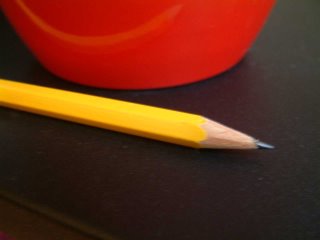 I liked to watch him work at his brown rolltop desk in the basement. I liked it best when he sharpened his pencils. The clean smell of sawdust mingled with the newly sharp dark tips. Each session was a rebirth. How proud I was when he allowed me to use the expensive, heavy metal sharpener he had attached to the wall, for in our house a sharpener was a tool of rare beauty.
I liked to watch him work at his brown rolltop desk in the basement. I liked it best when he sharpened his pencils. The clean smell of sawdust mingled with the newly sharp dark tips. Each session was a rebirth. How proud I was when he allowed me to use the expensive, heavy metal sharpener he had attached to the wall, for in our house a sharpener was a tool of rare beauty.
My little sharpener is light and airy and modern, an improved version, although I doubt my father would have thought so. All things can be improved.
Except a point.
For an interesting ramble around the world of pencils, visit The Pencil Pages! of the Incense Cedar Institute, California.

It is not enough to say the pumpkin is big. You have to weigh it to know how many pies you can bake from it.
The business of blogging, in Geneva
I start teaching a course on media research today. It took me a while to work out what the course is about. As a journalist, I think of research as something I do to get the information I need to prepare articles. This course covers the research that business people in the media need to do to keep their businesses going. I suddenly realized that as a weblog writer who wants to start a newspaper, I need this course. Good thing I get to teach it.
Where the web was born and blogging has a future
And yesterday I signed up to attend Lift06, a conference in Geneva (where the web was born, by the way) for bloggers, in early February. Since blogging, at least for me, lets me write in peace, I wouldn't normally be tempted out into the winter cold to meet other people who do the same. This is different: the program offers a lot about the present and future of blogging and some of the business aspects of it, like privacy and the law, and using new technologies in creative ways.
Measuring how to turn a blog into a newspaper
The class and the conference come together for me because I am working with other journalists to set up an online newspaper. At our first meeting it was clear the three journalists had three different approaches to what it should be, based on our individual knowledge of potential readership. Like most journalists, we are each sure we are well informed and therefore right.
Lesson one in my course is why we do research, and the starting point is very simple: when you want to create a new media outlet and you have three opinions about why, and who will read it, you need to move from opinion to research. Who are those people out there and what do they say they want to read? How and how often?
Will blogs still be fun if we measure our readers?
Blogs are great fun because we can follow our instincts, and learn from them. I think someone will want to read about celery and I think more people will want to read about chocolate. My instinct is right: when I wrote about celery one person loved it. A very small fan club. When I wrote about chocolate, a lot of mysterious bloggers suddenly visited my site. Bigger fan club. But if I want to know if I should write about chocolate every day I should do a survey.
Sadly, I don't think I can keep a chocolate lovers' newspaper alive, so we'll be asking what else people want to read about.
My 1000th visitor to my nearly 10 week old blog is from Japan! Welcome and thank you, Daita, for sharing your beautiful photos of race horses on a ranch in Japan.
I posted a photo of Daita's yesterday and wrote to ask his permission. I could see, on Site Meter, that someone from Japan who received a Flickr message, was visitor no. 1012. Since 12 of those visitors were me (silly mistake in setting up Site Meter), he is number 1000.
Take a look at his wonderful photos on Flickr, including this one in a larger size.